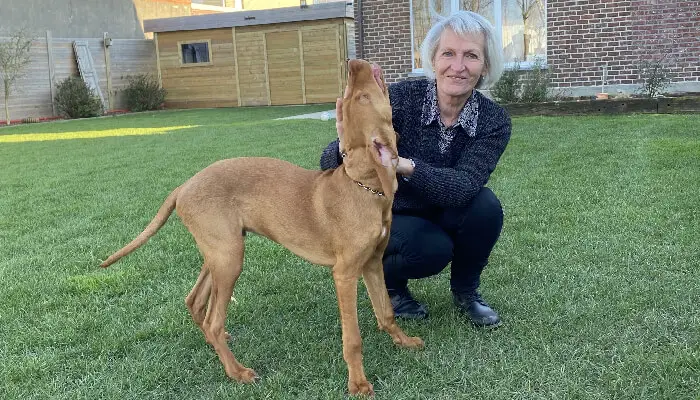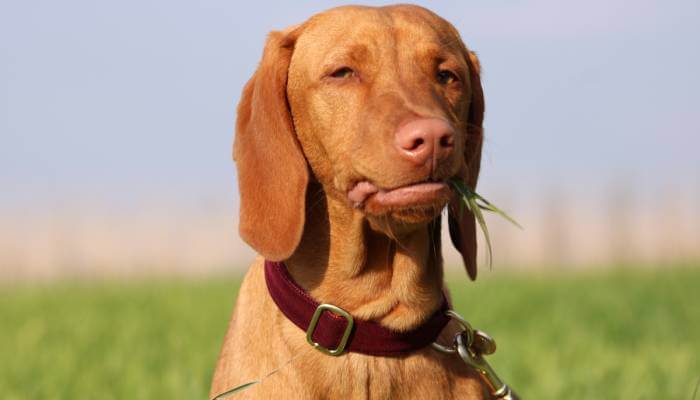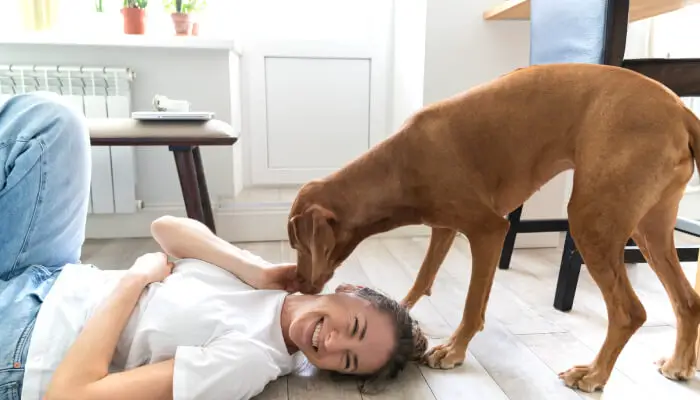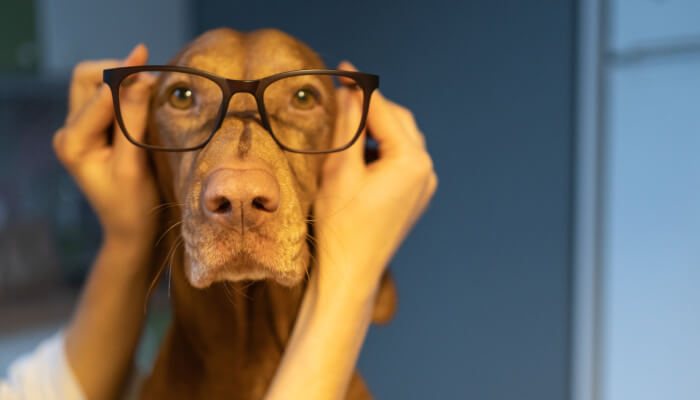Vizslas are popular, beautiful dogs that make great companions and family pets. But, unfortunately, one of the most common questions people ask about these intelligent, energetic dogs is, “Is my Vizsla too skinny?” The answer to this question is not always straightforward, as different breeds have their body types, but there are a few signs you can look for to determine if your Vizsla needs more food or exercise. Let’s find out the ways to know if your vizsla is underweight or not.
Your Vizsla may be underweight if they are always hungry, not gaining any weight despite feeding them regularly, and eating a quality, balanced diet. The signs of underweight Vizsla are that they have a thin waist, ribs, and spine visible when viewed from the front or rear. The Vizsla is also not on their feet much and has an inverted “V” shape to their back.
The top three reasons for underweight Vizslas are too many calories about exercise, lack of appetite, or intestinal problems. If your Vizsla is always hungry, they may be skinny and need to consume more calories while exercising less.
This can be a sign of too many calories concerning an exercise or lack of appetite from an underlying health problem like diabetes, Cushing’s disease, hypothyroidism, or inflammatory bowel disease.
In the following article, we will review some of the most common causes for Vizslas to be underweight and provide a few tips on how you can tell if your dog has an appropriate weight.
In this article, we will discuss seven ways you can tell whether your Vizsla needs fewer calories or more physical activity to maintain an appropriate weight!
Is It Bad That My Vizsla Is Skinny?
No! It’s perfectly normal for Vizslas to be skinny. This is just how they are built, and there’s nothing you should worry about most of the time. Vizsla is supposed to be thin and slim!
Some Vizslas have a higher metabolism than others, which is why they can maintain weight levels without much effort. It may be because of the breed or just their genetics, and it’s not something that you should worry about too much unless your dog starts losing weight for no reason at all.
Vizslas are not a muscular breed of dog. Instead, they have a sleek, thin build which is perfect for hunting and general activity.
There are many reasons why your Vizsla may be skinny such as their breed, lack of exercise, or an extremely active lifestyle! You can help them get back to that healthy weight by giving them more food than usual and exercising with them, so they stay slim and trim. Unfortunately, they have a skinny build, so they need some extra help to put on weight!
7 Ways To Know If My Vizsla Is Underweight?
Some breeds have body types that are predisposed towards being thin, such as the Vizsla. Conversely, these breeds tend to be overweight, such as the Bulldog. Generally speaking; however, all dog breeds can fall on either end of the spectrum, and it’s important to monitor your Vizsla’s weight constantly!
Vizslas are some of the most intelligent and energetic dogs, but they also tend to be “thin.” This often leads people to wonder is my Vizsla too skinny? Unfortunately, the answer isn’t always straightforward because different breeds will show their weight differently (e.g., Bulldogs may not look underweight when in reality they are). In addition, You need to look out for any concerning physical features such as sunken eyes, sagging skin, poor coat quality, and difficulty in walking. If you’re not sure if your Vizsla is the perfect weight or not then speak with your veterinarian!
Check Your Vizsla’s Body Shape
Sometimes it can be difficult to tell if your Vizsla is underweight or not. One way you can determine this, however, is by looking at the shape of its body. For example, if your Vizsla has a long and slender frame with a thin neck then there’s a chance they may need more food or exercise in order to maintain a healthy weight. A medium-framed Vizsla with a thicker neck, on the other hand, maybe at an appropriate weight!
Feel For Your Vizsla’s Ribs
Another way to tell if your Vizsla is underweight or not is by looking for any visible ribs and spine bones through their skin as these are common signs of being too thin.
You can also use your hands to check if your Vizsla is underweight or not. Place one hand on the top of their back and feel for any protruding rib bones. If you can quickly feel them through their skin, they may need more food to maintain a healthy weight!
Look At Your Vizsla From The Side To See If It Is Underweight Or Not
When your Vizsla is standing up, look at its body from the side. If you can see a defined was, they may need more food or exercise to maintain an appropriate weight!
Examine Your Vizsla’s Behavior
Some Vizslas are very active and energetic while others may be relatively inactive. If your Vizsla is always hungry, there’s a chance they may need to consume more calories or exercise less in order to maintain an appropriate weight!
The behavior of Vizsla is quite different when they are underweight as they tend to be less active. If your Vizsla is usually hyperactive but has become inactive lately, then it’s possible they may need more food or exercise in order to maintain an appropriate weight!
If you’re not sure if your Vizsla needs more calories or just a change of activity, speak with their veterinarian for advice on the best care for them.
Weigh Your Vizsla
If you’re not sure if your Vizsla is underweight or not, weighing them can provide some insight. However, when it comes to weight measurements, always remember that every dog breed will have a different idea of what’s appropriate for their size and age!
The average weight of a healthy Vizsla is between 25-35 pounds. Therefore, Vizslas weighing under 24 pounds are underweight while Vizslas over 35 lbs. overweight!
Consider The Health Effects Of Being Underweight In Vizsla
If your Vizslas have a very low weight, it’s possible they are undernourished or not getting enough physical exercise. Underweight Vizsla can also suffer from muscle atrophy which means their muscles will start to shrink due to lack of activity and the inability to move around as much
Health Issues that underweight Vizsla suffer from are:
- Muscle atrophy
- Loss of appetite or refusal to eat
- Sensitivity to cold temperatures
- Skin lesions
- Hair loss.
Make A Vet Examine Your Vizsla
The final way to determine if your Vizsla is underweight or not is by having a veterinarian examine them. Other symptoms of being too thin are diarrhea, vomiting, and hair loss.
You must get your Vizsla checked out as soon as possible so they can receive the appropriate care!
Why Is My Vizsla So Skinny?
If you’re not sure why your Vizsla is so skinny, there are a few possible explanations. First, it’s common for Vizslas to go through periods of weight loss and gain to maintain an appropriate fitness level. If this is the case, they may need to be fed more or given less activity so their weight levels out.
It’s also possible that your Vizsla has an underlying health condition such as diabetes, high blood pressure, kidney disease, etc. To determine if it’s one of these conditions causing them to lose weight, you should examine your Vizsla by a veterinarian.
It’s not uncommon for underweight Vizslas to eat their hair or start chewing on things in the house during times of stress! If this is happening with your dog, it may be because they are bored and need more activities that keep them stimulated.
Refusing Food Is May Be The Reason Why Your Vizsla Is Underweight
If your Vizsla is refusing food, there’s a chance they may be bored with their current diet or have something wrong with them. It could also mean that you need to provide more variety for your dog to get enough nutrition from the food!
When it comes down to good nutrition and regular exercise, most Vizslas will have a very healthy weight. If you’re not sure if your Vizsla needs more calories or just a change in activity, speak with their veterinarian for advice on the best care for them!
Old Age
If your Vizsla is about to turn eight years old, they are going into their senior years. As a dog ages and goes through different stages of life, it can lose weight!
The best way to care for an older Vizsla with low weight is by feeding them high-calorie foods with the appropriate nutrients for their age. However, weight loss in Vizslas is also a sign of malnutrition or diabetes, so it’s always best to take them to the vet as soon as you notice any symptoms.
If we’re talking about an older dog diagnosed with low blood sugar levels and is having trouble fighting off infections due to lack of energy, then the best thing you can do is feed them high-quality, low-calorie food.
Fewer Calories In Vizsla Diet
If your Vizsla is refusing food, they may be bored of the same old diet. But, on the other hand, it’s possible that you haven’t been providing them with enough variety for them to get a healthy amount of nutrients from their food!
It can also mean that they need more exercise or just an increase in calories not to lose weight. If this is the case, speak with their veterinarian to get advice on how you can best care for your Vizsla!
It would help if you had a conversation with your vet about what they think might be wrong and why your dog isn’t eating. This way, you’ll know exactly what steps need to take place for your Vizsla to be healthy!
Low-Quality Food Is The Reason Why Your Vizsla Is Skinny
If your Vizsla is eating a low-quality diet, they are likely to lose weight. This can be due to a lack of nutrients being consumed or the food not having enough calories in it for them!
It’s possible that their digestive system has been weakened by parasites and isn’t able to process their food properly. In this case, it’s necessary to find better quality food for them that will help strengthen their immune system and improve their digestion!
Too Much Physical Activities
Too much exercise can lead to your dog’s weight going down! This is because they’re burning so many calories and not taking in enough food. Exercise and physical activity are good to some extent, but when it’s more than what they need, your dog could be at risk of losing weight.
Undetected Health Issues In Vizsla
Excessive weight loss in a Vizsla can be due to an underlying health issue like diabetes or parasites. If you have any suspicions about your dog’s weight, it’s always best to ask a vet to check them out!
If we’re talking about an older dog diagnosed with low blood sugar levels and is having trouble fighting off infections due to lack of energy, then the best thing you can do is feed them high-quality, low-calorie food.
How Do I Get My Skinny Puppy To Gain Weight?
Many people mistakenly think that a dog is too skinny when in reality, they’re just the right weight! If you believe your Vizsla is underweight, there are many ways to help them put on healthy pounds without overfeeding them.
The best thing you can do is feed them high-quality, low-calorie food. Keeping your Vizsla trim and fit is important, but it’s not the same as purposefully putting on weight.
If your Vizsla is refusing food, there is a chance that they are bored of the same old diet. But, on the other hand, it’s possible that you haven’t been providing them with enough variety for them to get a healthy amount of nutrients from their food! If this is the case, speak with their veterinarian to get advice on how you can best care for your Vizsla!
Feed small meals throughout the day or consider free feeding
Provide your dog with various food sources and flavors to help them become interested in their meal.
Please don’t feed them any table scraps or human-grade foods that will add too many calories!
Add extra fat such as bacon grease, olive oil, butter, or coconut oil so they can absorb the nutrients from their diet.
Give them high-calorie, low-quality food sources such as eggs or peanut butter to supplement their diet.
Add weight to your dog’s frame by exercising with them and making sure they get enough rest!
Supplement meals with snacks That Vizsla Prefer
Some foods are especially good at helping dogs maintain an appropriate weight level, such as Hill’s Science Diet.
Hill’s Science Diet is a food that has been designed to help put on healthy pounds and keep them from losing too much weight! Depending on the dog, it can come in different flavors, but it will always have high-quality ingredients with lower calories. Therefore, this kind of food should be used sparingly and in conjunction with low-calorie, high-quality food!
Add extra fat such as bacon grease, olive oil, butter, or coconut oil so they can absorb the nutrients from their diet.
Give them high-calorie, low-quality food sources such as eggs or peanut butter to supplement their diet. Snacks, such as eggs, cheese, or peanut butter that Vizsla dogs prefer, are an excellent way of boosting their weight.
For example, giving your dog some smoked salmon is not only tasty for the Vizsla, but it also has fat and protein in it, which will contribute to a healthy coat and skin while adding on pounds.
Use wet or fresh foods For Vizsla.
Again, Hill’s Science Diet is an excellent option for dogs who need to put on weight. You can also try feeding your Vizsla wet food or fresh foods such as boiled chicken breast with some water in it.
Canned dog food is an excellent way of getting your pet back up to their healthy weight and is an easy way to get them the nutrients they need. If you’re unsure what type of food your Vizsla will like, canned food is a great place to start!
Choose a higher calorie food For Your Vizsla.
If you’re getting your dog to gain weight, then try a higher-calorie food. The good idea is to buy Pedigree Adult Complete Nutrition which has lower calories and gives the Vizsla all their nutritional requirements in one meal!
Issues That Your Underweight Vizsla Have To Endure
Underweight Vizslas are more prone to illness and have issues with their joints, skin, and bones. In addition, when a dog is underfed, they lose muscle mass which puts pressure on the skeleton.
A skinny canine will also be less likely to properly regulate body temperature, which means that they may need extra care in colder climates! Therefore, keeping them warm enough is one of the most important things you can do for an underweight Vizsla.
Keeping your dog’s weight up will ensure that they are less likely to develop illnesses and complications throughout their life!
Canine illnesses that can develop from being underweight include, but are not limited to, skin problems, joint issues, dental disease, bloat, and organ failure. Chronic health issues in underweight Vizsla will include arthritis, allergies, and other skin problems.
Conclusion
As much as I love watching my Vizsla run around the yard with her nose pointed at the sky, she must get enough food and water to maintain a healthy weight! If your dog has been refusing food or getting thinner, it may be because they are bored with the same old diet and don’t have enough room for variety.
If you have any questions, please feel free to reach out! I hope this has helped you with your pup’s weight problem!”



